Leadership and Management: Risk Assessment, Planning & Performance
VerifiedAdded on 2023/06/10
|14
|2700
|147
Report
AI Summary
This report provides a comprehensive overview of leadership and management principles with a focus on risk assessment and workplace operations. It begins by examining risk management procedures, emphasizing the importance of context, scope, and evaluation criteria. Various tools and techniques for identifying risk factors, such as documentation evaluation, brainstorming, the Delphi technique, interview, assumption analysis, and influence diagrams are discussed. The report then delves into the stakeholder paradigm and the significance of cultural and social associations in risk perception. It provides a detailed risk assessment matrix, highlighting the calculation of risk levels based on likelihood and impact. Furthermore, the report identifies common workplace hazards, like poor housekeeping, and stresses the importance of communication with stakeholders. The second part of the report addresses workplace operations, including contingency planning, employee recruitment, performance management, and strategies for improving business productivity. It also covers the qualities of a proficient mentor, data security measures, and key performance indicators. Finally, the report discusses the components of an operational plan, factors for achieving key performance indicators, and the significance of employee induction and budget monitoring. This document is available on Desklib, a platform offering a range of study tools and solved assignments for students.
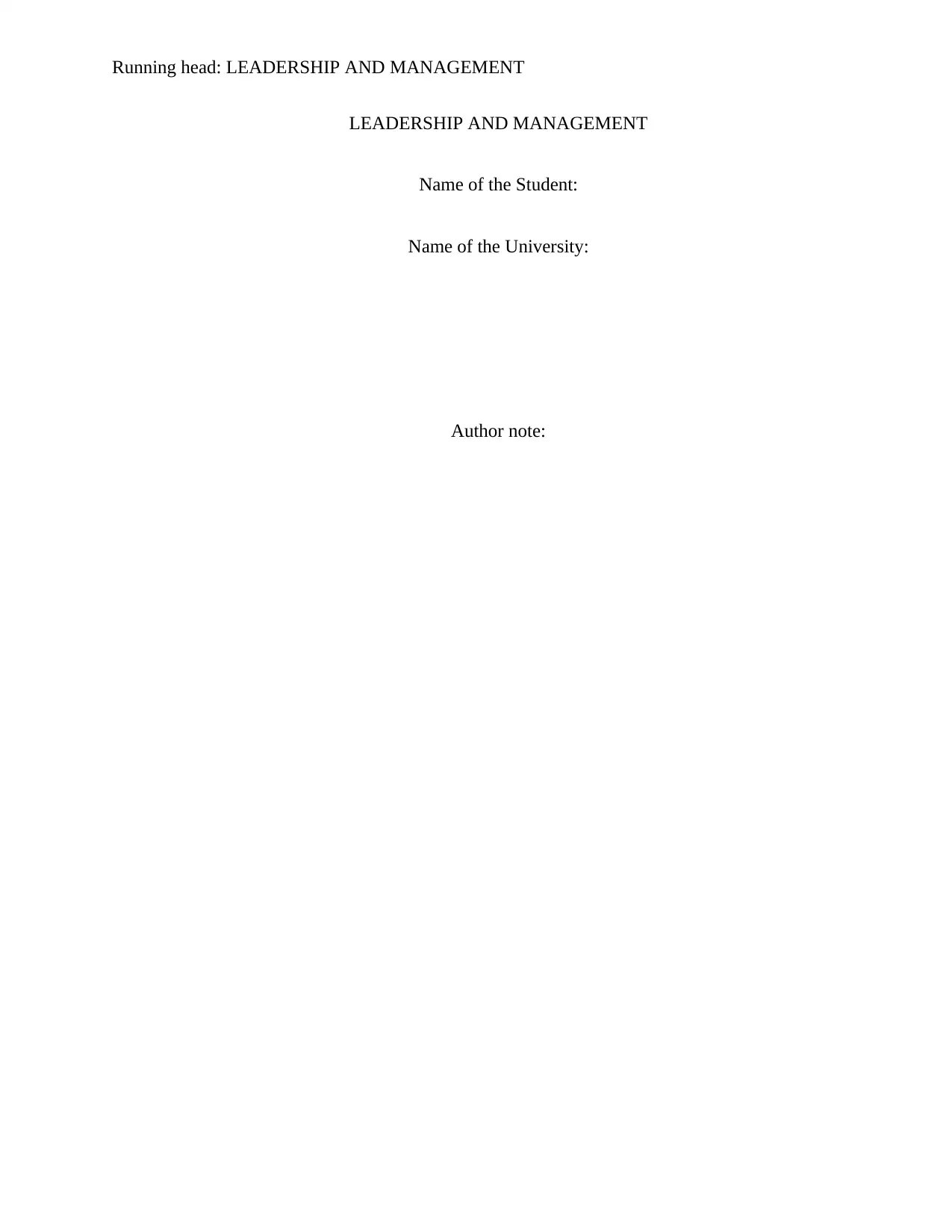
Running head: LEADERSHIP AND MANAGEMENT
LEADERSHIP AND MANAGEMENT
Name of the Student:
Name of the University:
Author note:
LEADERSHIP AND MANAGEMENT
Name of the Student:
Name of the University:
Author note:
Paraphrase This Document
Need a fresh take? Get an instant paraphrase of this document with our AI Paraphraser
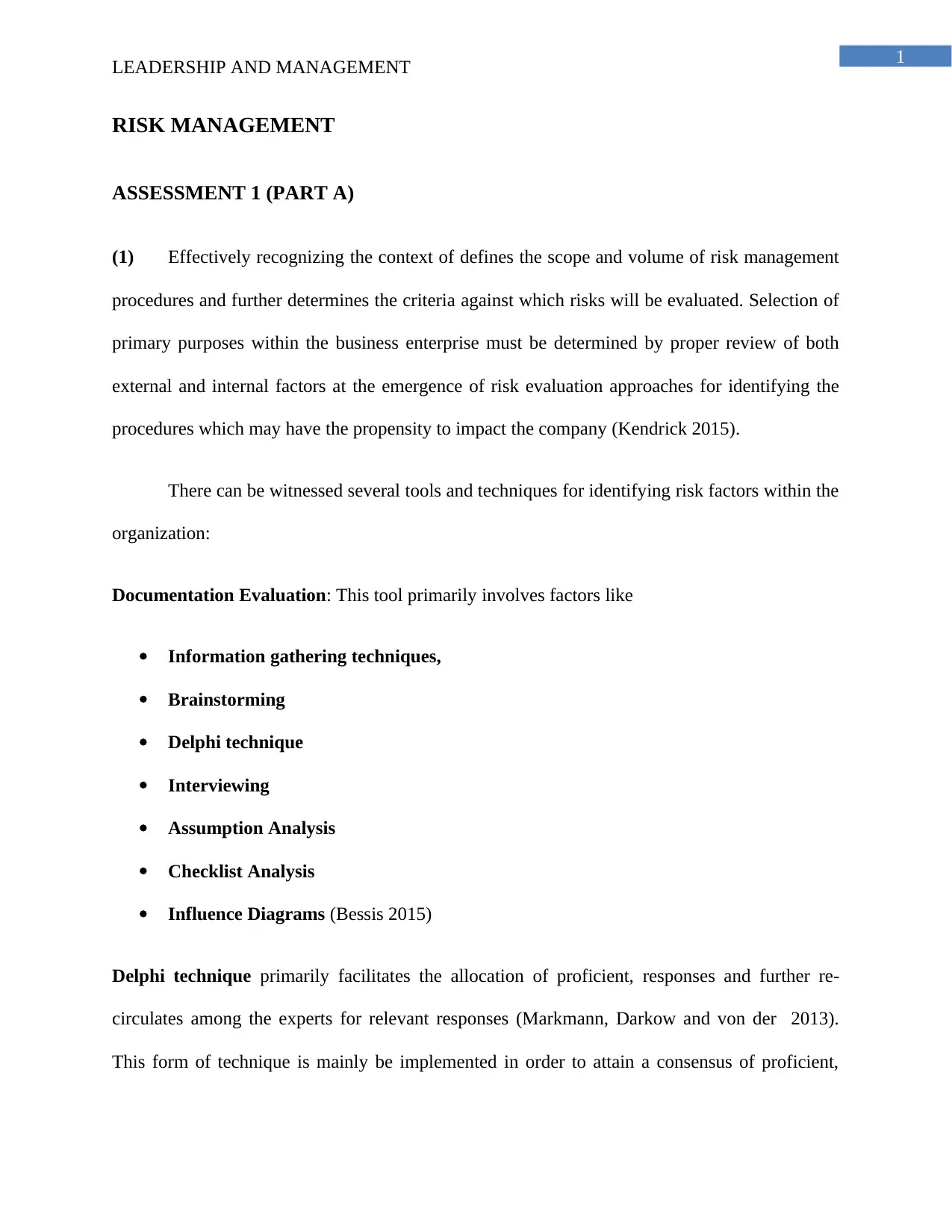
1
LEADERSHIP AND MANAGEMENT
RISK MANAGEMENT
ASSESSMENT 1 (PART A)
(1) Effectively recognizing the context of defines the scope and volume of risk management
procedures and further determines the criteria against which risks will be evaluated. Selection of
primary purposes within the business enterprise must be determined by proper review of both
external and internal factors at the emergence of risk evaluation approaches for identifying the
procedures which may have the propensity to impact the company (Kendrick 2015).
There can be witnessed several tools and techniques for identifying risk factors within the
organization:
Documentation Evaluation: This tool primarily involves factors like
Information gathering techniques,
Brainstorming
Delphi technique
Interviewing
Assumption Analysis
Checklist Analysis
Influence Diagrams (Bessis 2015)
Delphi technique primarily facilitates the allocation of proficient, responses and further re-
circulates among the experts for relevant responses (Markmann, Darkow and von der 2013).
This form of technique is mainly be implemented in order to attain a consensus of proficient,
LEADERSHIP AND MANAGEMENT
RISK MANAGEMENT
ASSESSMENT 1 (PART A)
(1) Effectively recognizing the context of defines the scope and volume of risk management
procedures and further determines the criteria against which risks will be evaluated. Selection of
primary purposes within the business enterprise must be determined by proper review of both
external and internal factors at the emergence of risk evaluation approaches for identifying the
procedures which may have the propensity to impact the company (Kendrick 2015).
There can be witnessed several tools and techniques for identifying risk factors within the
organization:
Documentation Evaluation: This tool primarily involves factors like
Information gathering techniques,
Brainstorming
Delphi technique
Interviewing
Assumption Analysis
Checklist Analysis
Influence Diagrams (Bessis 2015)
Delphi technique primarily facilitates the allocation of proficient, responses and further re-
circulates among the experts for relevant responses (Markmann, Darkow and von der 2013).
This form of technique is mainly be implemented in order to attain a consensus of proficient,
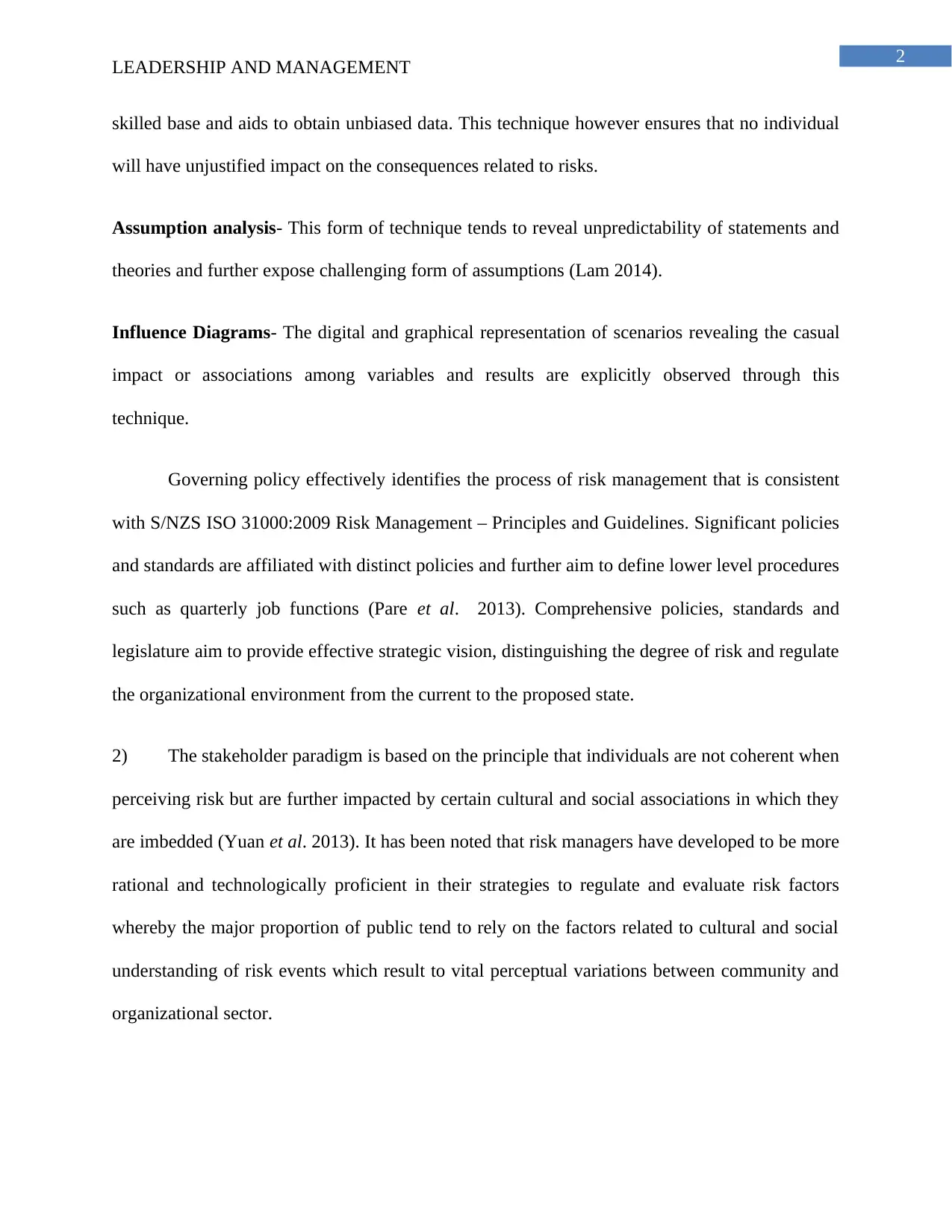
2
LEADERSHIP AND MANAGEMENT
skilled base and aids to obtain unbiased data. This technique however ensures that no individual
will have unjustified impact on the consequences related to risks.
Assumption analysis- This form of technique tends to reveal unpredictability of statements and
theories and further expose challenging form of assumptions (Lam 2014).
Influence Diagrams- The digital and graphical representation of scenarios revealing the casual
impact or associations among variables and results are explicitly observed through this
technique.
Governing policy effectively identifies the process of risk management that is consistent
with S/NZS ISO 31000:2009 Risk Management – Principles and Guidelines. Significant policies
and standards are affiliated with distinct policies and further aim to define lower level procedures
such as quarterly job functions (Pare et al. 2013). Comprehensive policies, standards and
legislature aim to provide effective strategic vision, distinguishing the degree of risk and regulate
the organizational environment from the current to the proposed state.
2) The stakeholder paradigm is based on the principle that individuals are not coherent when
perceiving risk but are further impacted by certain cultural and social associations in which they
are imbedded (Yuan et al. 2013). It has been noted that risk managers have developed to be more
rational and technologically proficient in their strategies to regulate and evaluate risk factors
whereby the major proportion of public tend to rely on the factors related to cultural and social
understanding of risk events which result to vital perceptual variations between community and
organizational sector.
LEADERSHIP AND MANAGEMENT
skilled base and aids to obtain unbiased data. This technique however ensures that no individual
will have unjustified impact on the consequences related to risks.
Assumption analysis- This form of technique tends to reveal unpredictability of statements and
theories and further expose challenging form of assumptions (Lam 2014).
Influence Diagrams- The digital and graphical representation of scenarios revealing the casual
impact or associations among variables and results are explicitly observed through this
technique.
Governing policy effectively identifies the process of risk management that is consistent
with S/NZS ISO 31000:2009 Risk Management – Principles and Guidelines. Significant policies
and standards are affiliated with distinct policies and further aim to define lower level procedures
such as quarterly job functions (Pare et al. 2013). Comprehensive policies, standards and
legislature aim to provide effective strategic vision, distinguishing the degree of risk and regulate
the organizational environment from the current to the proposed state.
2) The stakeholder paradigm is based on the principle that individuals are not coherent when
perceiving risk but are further impacted by certain cultural and social associations in which they
are imbedded (Yuan et al. 2013). It has been noted that risk managers have developed to be more
rational and technologically proficient in their strategies to regulate and evaluate risk factors
whereby the major proportion of public tend to rely on the factors related to cultural and social
understanding of risk events which result to vital perceptual variations between community and
organizational sector.
⊘ This is a preview!⊘
Do you want full access?
Subscribe today to unlock all pages.

Trusted by 1+ million students worldwide
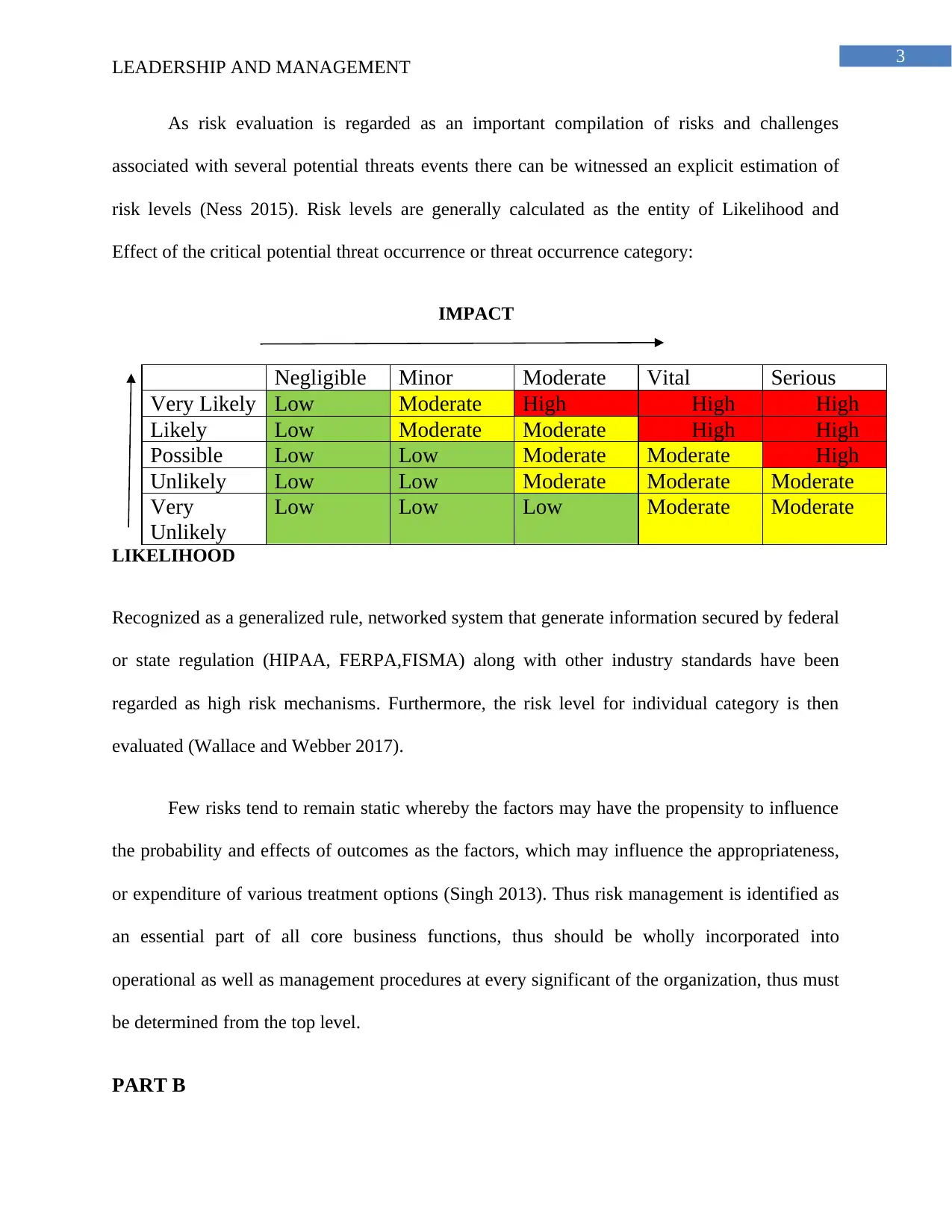
3
LEADERSHIP AND MANAGEMENT
As risk evaluation is regarded as an important compilation of risks and challenges
associated with several potential threats events there can be witnessed an explicit estimation of
risk levels (Ness 2015). Risk levels are generally calculated as the entity of Likelihood and
Effect of the critical potential threat occurrence or threat occurrence category:
IMPACT
Negligible Minor Moderate Vital Serious
Very Likely Low Moderate High High High
Likely Low Moderate Moderate High High
Possible Low Low Moderate Moderate High
Unlikely Low Low Moderate Moderate Moderate
Very
Unlikely
Low Low Low Moderate Moderate
LIKELIHOOD
Recognized as a generalized rule, networked system that generate information secured by federal
or state regulation (HIPAA, FERPA,FISMA) along with other industry standards have been
regarded as high risk mechanisms. Furthermore, the risk level for individual category is then
evaluated (Wallace and Webber 2017).
Few risks tend to remain static whereby the factors may have the propensity to influence
the probability and effects of outcomes as the factors, which may influence the appropriateness,
or expenditure of various treatment options (Singh 2013). Thus risk management is identified as
an essential part of all core business functions, thus should be wholly incorporated into
operational as well as management procedures at every significant of the organization, thus must
be determined from the top level.
PART B
LEADERSHIP AND MANAGEMENT
As risk evaluation is regarded as an important compilation of risks and challenges
associated with several potential threats events there can be witnessed an explicit estimation of
risk levels (Ness 2015). Risk levels are generally calculated as the entity of Likelihood and
Effect of the critical potential threat occurrence or threat occurrence category:
IMPACT
Negligible Minor Moderate Vital Serious
Very Likely Low Moderate High High High
Likely Low Moderate Moderate High High
Possible Low Low Moderate Moderate High
Unlikely Low Low Moderate Moderate Moderate
Very
Unlikely
Low Low Low Moderate Moderate
LIKELIHOOD
Recognized as a generalized rule, networked system that generate information secured by federal
or state regulation (HIPAA, FERPA,FISMA) along with other industry standards have been
regarded as high risk mechanisms. Furthermore, the risk level for individual category is then
evaluated (Wallace and Webber 2017).
Few risks tend to remain static whereby the factors may have the propensity to influence
the probability and effects of outcomes as the factors, which may influence the appropriateness,
or expenditure of various treatment options (Singh 2013). Thus risk management is identified as
an essential part of all core business functions, thus should be wholly incorporated into
operational as well as management procedures at every significant of the organization, thus must
be determined from the top level.
PART B
Paraphrase This Document
Need a fresh take? Get an instant paraphrase of this document with our AI Paraphraser

4
LEADERSHIP AND MANAGEMENT
Immense turmoil at fire exits, aisles along with the emergency exit path is recognized as a
vital housekeeping hazard for an organization that deals with global marketing services (Wallace
and Webber 2017). Even if the clearance between stored supplies as well as circuit breakers is
suitable, the lack of employee accountability tends to emerge these hazardous situations.
Effective communication with both internal and external stakeholders such as employees,
shareholders and management along with other parties is necessary during process of risk
management (Singh 2013). As supervisors and stakeholders are highly accountable for poor
housekeeping hazards it is vital to expand the awareness while evaluating the risk event.
Certain observations revealed that the storage rack utilized was hazardous as it revealed a
significant lack of diagonal bracings and thus has been susceptible to malfunction or collapse.
Further findings reveal that storage rack comprised only horizontal bracings and was neither
attached to the wall of warehouse floor (Markmann, Darkow and von der 2013).
It is immensely vital to explicitly identify the various occurrences of risks which tend to
cause harm. These identified risks further can be recognized as
Chemical hazard (utilized in the task that is being executed such as liquid nitrogen
Materials- Toxic, radioactive, blood, aggravation, injury
Equipment- Electric shock, vibration, fire (Yuan et al. 2013)
Biological- Potential contact with blood borne infections and germs along with highly
contaminated wastes.
Environment- Hot or searing surface, low temperature, disposal areas, staff and
information
LEADERSHIP AND MANAGEMENT
Immense turmoil at fire exits, aisles along with the emergency exit path is recognized as a
vital housekeeping hazard for an organization that deals with global marketing services (Wallace
and Webber 2017). Even if the clearance between stored supplies as well as circuit breakers is
suitable, the lack of employee accountability tends to emerge these hazardous situations.
Effective communication with both internal and external stakeholders such as employees,
shareholders and management along with other parties is necessary during process of risk
management (Singh 2013). As supervisors and stakeholders are highly accountable for poor
housekeeping hazards it is vital to expand the awareness while evaluating the risk event.
Certain observations revealed that the storage rack utilized was hazardous as it revealed a
significant lack of diagonal bracings and thus has been susceptible to malfunction or collapse.
Further findings reveal that storage rack comprised only horizontal bracings and was neither
attached to the wall of warehouse floor (Markmann, Darkow and von der 2013).
It is immensely vital to explicitly identify the various occurrences of risks which tend to
cause harm. These identified risks further can be recognized as
Chemical hazard (utilized in the task that is being executed such as liquid nitrogen
Materials- Toxic, radioactive, blood, aggravation, injury
Equipment- Electric shock, vibration, fire (Yuan et al. 2013)
Biological- Potential contact with blood borne infections and germs along with highly
contaminated wastes.
Environment- Hot or searing surface, low temperature, disposal areas, staff and
information

5
LEADERSHIP AND MANAGEMENT
West Moonah Community House Inc Policy has revealed utmost involvement to the
prevention and harm by further providing a secured and healthy working environment
(Chartier et al. 2014). The policy further purposes to regulate the procedures in the
workplace in order to guarantee that all indignant and ill-treated employees attain the
important area of avenue to recover and commence work by offering appropriate duties for
an injured employee as an essential part of the rehabilitation procedures.
LEADERSHIP AND MANAGEMENT
West Moonah Community House Inc Policy has revealed utmost involvement to the
prevention and harm by further providing a secured and healthy working environment
(Chartier et al. 2014). The policy further purposes to regulate the procedures in the
workplace in order to guarantee that all indignant and ill-treated employees attain the
important area of avenue to recover and commence work by offering appropriate duties for
an injured employee as an essential part of the rehabilitation procedures.
⊘ This is a preview!⊘
Do you want full access?
Subscribe today to unlock all pages.

Trusted by 1+ million students worldwide
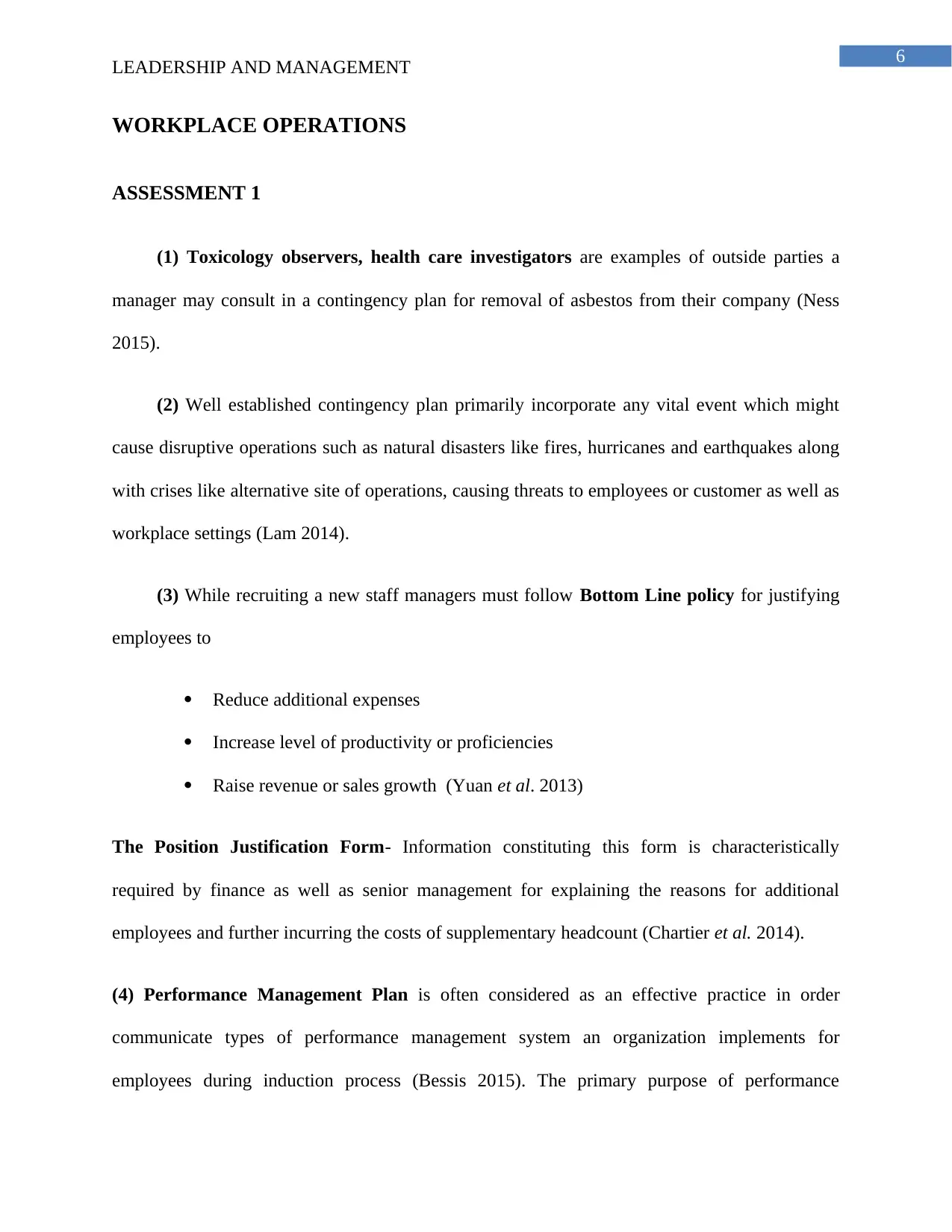
6
LEADERSHIP AND MANAGEMENT
WORKPLACE OPERATIONS
ASSESSMENT 1
(1) Toxicology observers, health care investigators are examples of outside parties a
manager may consult in a contingency plan for removal of asbestos from their company (Ness
2015).
(2) Well established contingency plan primarily incorporate any vital event which might
cause disruptive operations such as natural disasters like fires, hurricanes and earthquakes along
with crises like alternative site of operations, causing threats to employees or customer as well as
workplace settings (Lam 2014).
(3) While recruiting a new staff managers must follow Bottom Line policy for justifying
employees to
Reduce additional expenses
Increase level of productivity or proficiencies
Raise revenue or sales growth (Yuan et al. 2013)
The Position Justification Form- Information constituting this form is characteristically
required by finance as well as senior management for explaining the reasons for additional
employees and further incurring the costs of supplementary headcount (Chartier et al. 2014).
(4) Performance Management Plan is often considered as an effective practice in order
communicate types of performance management system an organization implements for
employees during induction process (Bessis 2015). The primary purpose of performance
LEADERSHIP AND MANAGEMENT
WORKPLACE OPERATIONS
ASSESSMENT 1
(1) Toxicology observers, health care investigators are examples of outside parties a
manager may consult in a contingency plan for removal of asbestos from their company (Ness
2015).
(2) Well established contingency plan primarily incorporate any vital event which might
cause disruptive operations such as natural disasters like fires, hurricanes and earthquakes along
with crises like alternative site of operations, causing threats to employees or customer as well as
workplace settings (Lam 2014).
(3) While recruiting a new staff managers must follow Bottom Line policy for justifying
employees to
Reduce additional expenses
Increase level of productivity or proficiencies
Raise revenue or sales growth (Yuan et al. 2013)
The Position Justification Form- Information constituting this form is characteristically
required by finance as well as senior management for explaining the reasons for additional
employees and further incurring the costs of supplementary headcount (Chartier et al. 2014).
(4) Performance Management Plan is often considered as an effective practice in order
communicate types of performance management system an organization implements for
employees during induction process (Bessis 2015). The primary purpose of performance
Paraphrase This Document
Need a fresh take? Get an instant paraphrase of this document with our AI Paraphraser
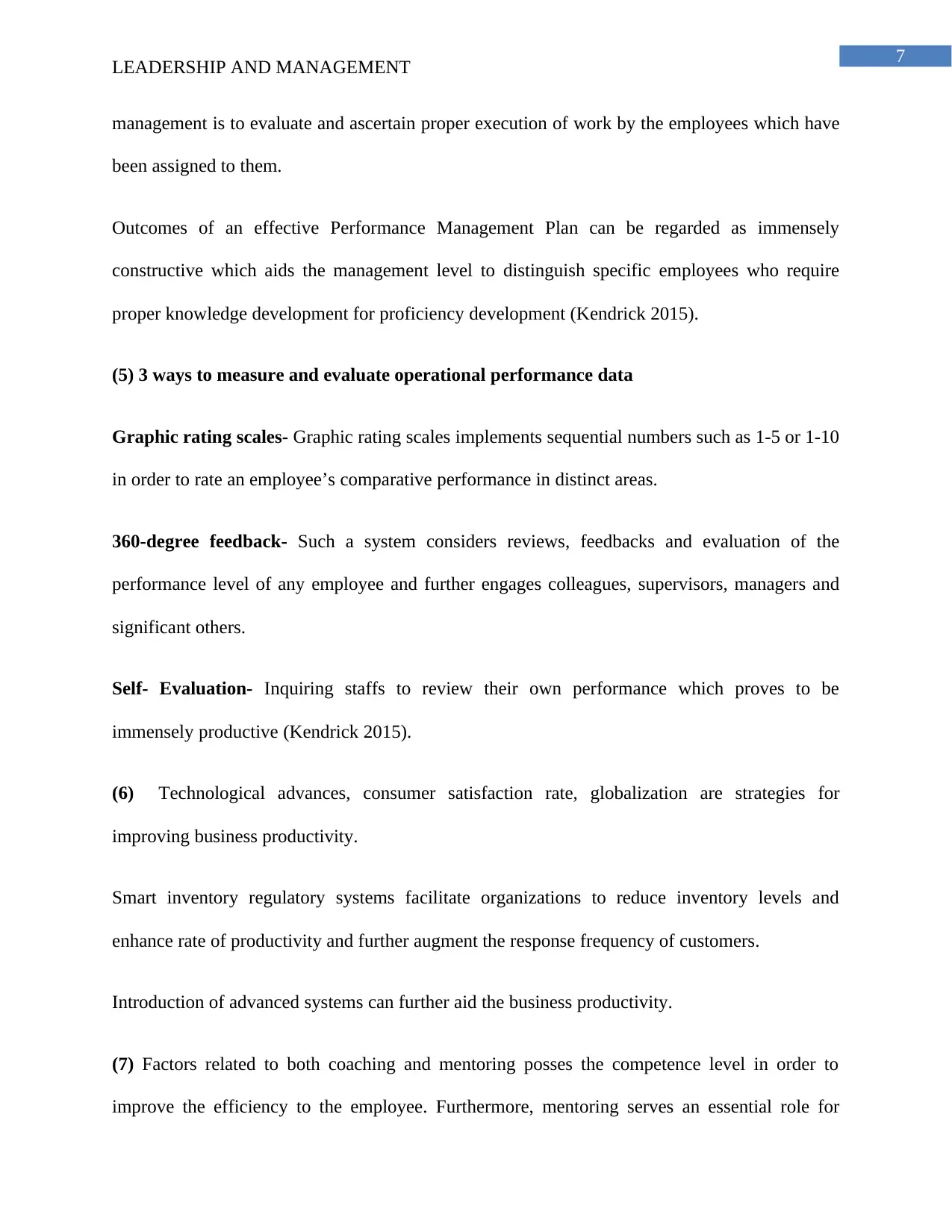
7
LEADERSHIP AND MANAGEMENT
management is to evaluate and ascertain proper execution of work by the employees which have
been assigned to them.
Outcomes of an effective Performance Management Plan can be regarded as immensely
constructive which aids the management level to distinguish specific employees who require
proper knowledge development for proficiency development (Kendrick 2015).
(5) 3 ways to measure and evaluate operational performance data
Graphic rating scales- Graphic rating scales implements sequential numbers such as 1-5 or 1-10
in order to rate an employee’s comparative performance in distinct areas.
360-degree feedback- Such a system considers reviews, feedbacks and evaluation of the
performance level of any employee and further engages colleagues, supervisors, managers and
significant others.
Self- Evaluation- Inquiring staffs to review their own performance which proves to be
immensely productive (Kendrick 2015).
(6) Technological advances, consumer satisfaction rate, globalization are strategies for
improving business productivity.
Smart inventory regulatory systems facilitate organizations to reduce inventory levels and
enhance rate of productivity and further augment the response frequency of customers.
Introduction of advanced systems can further aid the business productivity.
(7) Factors related to both coaching and mentoring posses the competence level in order to
improve the efficiency to the employee. Furthermore, mentoring serves an essential role for
LEADERSHIP AND MANAGEMENT
management is to evaluate and ascertain proper execution of work by the employees which have
been assigned to them.
Outcomes of an effective Performance Management Plan can be regarded as immensely
constructive which aids the management level to distinguish specific employees who require
proper knowledge development for proficiency development (Kendrick 2015).
(5) 3 ways to measure and evaluate operational performance data
Graphic rating scales- Graphic rating scales implements sequential numbers such as 1-5 or 1-10
in order to rate an employee’s comparative performance in distinct areas.
360-degree feedback- Such a system considers reviews, feedbacks and evaluation of the
performance level of any employee and further engages colleagues, supervisors, managers and
significant others.
Self- Evaluation- Inquiring staffs to review their own performance which proves to be
immensely productive (Kendrick 2015).
(6) Technological advances, consumer satisfaction rate, globalization are strategies for
improving business productivity.
Smart inventory regulatory systems facilitate organizations to reduce inventory levels and
enhance rate of productivity and further augment the response frequency of customers.
Introduction of advanced systems can further aid the business productivity.
(7) Factors related to both coaching and mentoring posses the competence level in order to
improve the efficiency to the employee. Furthermore, mentoring serves an essential role for
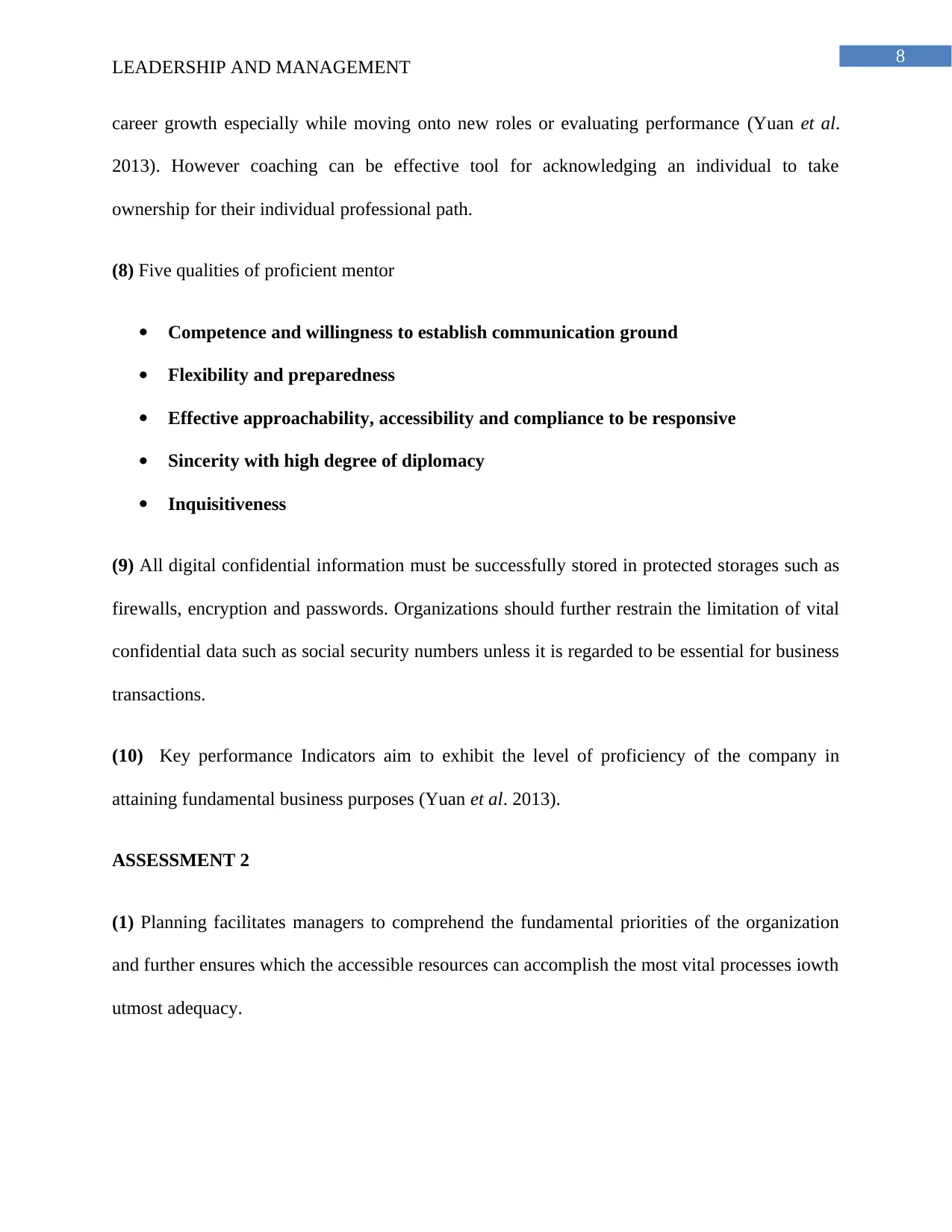
8
LEADERSHIP AND MANAGEMENT
career growth especially while moving onto new roles or evaluating performance (Yuan et al.
2013). However coaching can be effective tool for acknowledging an individual to take
ownership for their individual professional path.
(8) Five qualities of proficient mentor
Competence and willingness to establish communication ground
Flexibility and preparedness
Effective approachability, accessibility and compliance to be responsive
Sincerity with high degree of diplomacy
Inquisitiveness
(9) All digital confidential information must be successfully stored in protected storages such as
firewalls, encryption and passwords. Organizations should further restrain the limitation of vital
confidential data such as social security numbers unless it is regarded to be essential for business
transactions.
(10) Key performance Indicators aim to exhibit the level of proficiency of the company in
attaining fundamental business purposes (Yuan et al. 2013).
ASSESSMENT 2
(1) Planning facilitates managers to comprehend the fundamental priorities of the organization
and further ensures which the accessible resources can accomplish the most vital processes iowth
utmost adequacy.
LEADERSHIP AND MANAGEMENT
career growth especially while moving onto new roles or evaluating performance (Yuan et al.
2013). However coaching can be effective tool for acknowledging an individual to take
ownership for their individual professional path.
(8) Five qualities of proficient mentor
Competence and willingness to establish communication ground
Flexibility and preparedness
Effective approachability, accessibility and compliance to be responsive
Sincerity with high degree of diplomacy
Inquisitiveness
(9) All digital confidential information must be successfully stored in protected storages such as
firewalls, encryption and passwords. Organizations should further restrain the limitation of vital
confidential data such as social security numbers unless it is regarded to be essential for business
transactions.
(10) Key performance Indicators aim to exhibit the level of proficiency of the company in
attaining fundamental business purposes (Yuan et al. 2013).
ASSESSMENT 2
(1) Planning facilitates managers to comprehend the fundamental priorities of the organization
and further ensures which the accessible resources can accomplish the most vital processes iowth
utmost adequacy.
⊘ This is a preview!⊘
Do you want full access?
Subscribe today to unlock all pages.

Trusted by 1+ million students worldwide
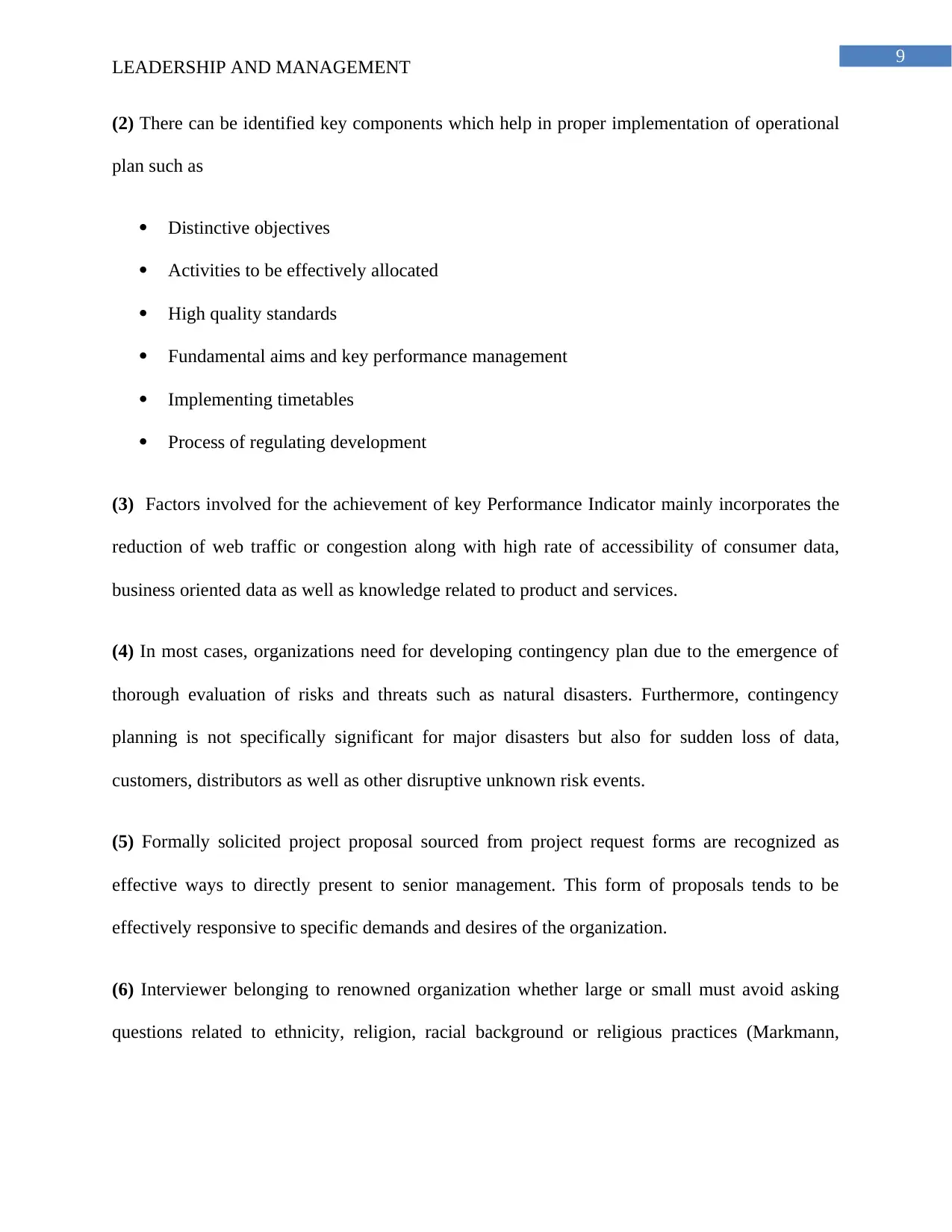
9
LEADERSHIP AND MANAGEMENT
(2) There can be identified key components which help in proper implementation of operational
plan such as
Distinctive objectives
Activities to be effectively allocated
High quality standards
Fundamental aims and key performance management
Implementing timetables
Process of regulating development
(3) Factors involved for the achievement of key Performance Indicator mainly incorporates the
reduction of web traffic or congestion along with high rate of accessibility of consumer data,
business oriented data as well as knowledge related to product and services.
(4) In most cases, organizations need for developing contingency plan due to the emergence of
thorough evaluation of risks and threats such as natural disasters. Furthermore, contingency
planning is not specifically significant for major disasters but also for sudden loss of data,
customers, distributors as well as other disruptive unknown risk events.
(5) Formally solicited project proposal sourced from project request forms are recognized as
effective ways to directly present to senior management. This form of proposals tends to be
effectively responsive to specific demands and desires of the organization.
(6) Interviewer belonging to renowned organization whether large or small must avoid asking
questions related to ethnicity, religion, racial background or religious practices (Markmann,
LEADERSHIP AND MANAGEMENT
(2) There can be identified key components which help in proper implementation of operational
plan such as
Distinctive objectives
Activities to be effectively allocated
High quality standards
Fundamental aims and key performance management
Implementing timetables
Process of regulating development
(3) Factors involved for the achievement of key Performance Indicator mainly incorporates the
reduction of web traffic or congestion along with high rate of accessibility of consumer data,
business oriented data as well as knowledge related to product and services.
(4) In most cases, organizations need for developing contingency plan due to the emergence of
thorough evaluation of risks and threats such as natural disasters. Furthermore, contingency
planning is not specifically significant for major disasters but also for sudden loss of data,
customers, distributors as well as other disruptive unknown risk events.
(5) Formally solicited project proposal sourced from project request forms are recognized as
effective ways to directly present to senior management. This form of proposals tends to be
effectively responsive to specific demands and desires of the organization.
(6) Interviewer belonging to renowned organization whether large or small must avoid asking
questions related to ethnicity, religion, racial background or religious practices (Markmann,
Paraphrase This Document
Need a fresh take? Get an instant paraphrase of this document with our AI Paraphraser
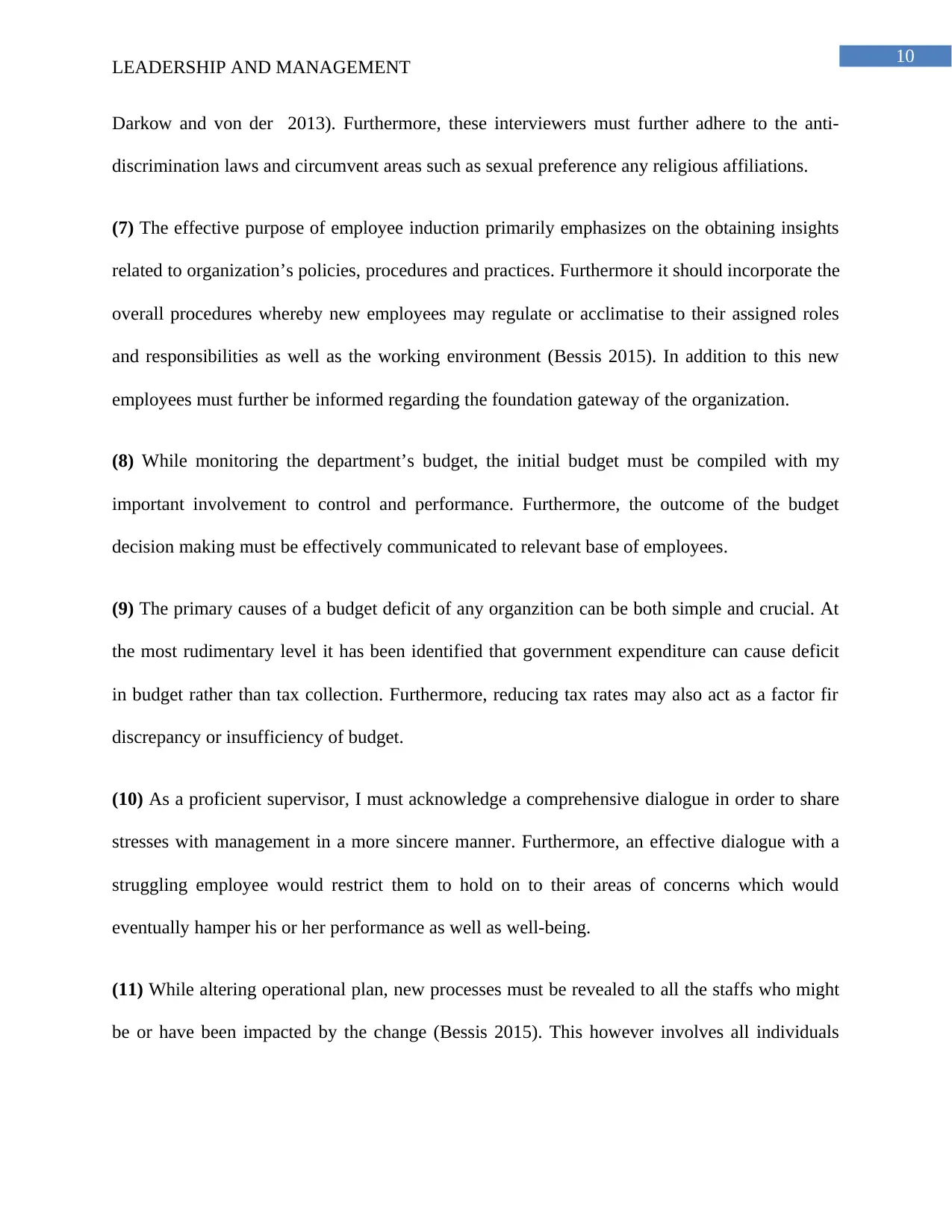
10
LEADERSHIP AND MANAGEMENT
Darkow and von der 2013). Furthermore, these interviewers must further adhere to the anti-
discrimination laws and circumvent areas such as sexual preference any religious affiliations.
(7) The effective purpose of employee induction primarily emphasizes on the obtaining insights
related to organization’s policies, procedures and practices. Furthermore it should incorporate the
overall procedures whereby new employees may regulate or acclimatise to their assigned roles
and responsibilities as well as the working environment (Bessis 2015). In addition to this new
employees must further be informed regarding the foundation gateway of the organization.
(8) While monitoring the department’s budget, the initial budget must be compiled with my
important involvement to control and performance. Furthermore, the outcome of the budget
decision making must be effectively communicated to relevant base of employees.
(9) The primary causes of a budget deficit of any organzition can be both simple and crucial. At
the most rudimentary level it has been identified that government expenditure can cause deficit
in budget rather than tax collection. Furthermore, reducing tax rates may also act as a factor fir
discrepancy or insufficiency of budget.
(10) As a proficient supervisor, I must acknowledge a comprehensive dialogue in order to share
stresses with management in a more sincere manner. Furthermore, an effective dialogue with a
struggling employee would restrict them to hold on to their areas of concerns which would
eventually hamper his or her performance as well as well-being.
(11) While altering operational plan, new processes must be revealed to all the staffs who might
be or have been impacted by the change (Bessis 2015). This however involves all individuals
LEADERSHIP AND MANAGEMENT
Darkow and von der 2013). Furthermore, these interviewers must further adhere to the anti-
discrimination laws and circumvent areas such as sexual preference any religious affiliations.
(7) The effective purpose of employee induction primarily emphasizes on the obtaining insights
related to organization’s policies, procedures and practices. Furthermore it should incorporate the
overall procedures whereby new employees may regulate or acclimatise to their assigned roles
and responsibilities as well as the working environment (Bessis 2015). In addition to this new
employees must further be informed regarding the foundation gateway of the organization.
(8) While monitoring the department’s budget, the initial budget must be compiled with my
important involvement to control and performance. Furthermore, the outcome of the budget
decision making must be effectively communicated to relevant base of employees.
(9) The primary causes of a budget deficit of any organzition can be both simple and crucial. At
the most rudimentary level it has been identified that government expenditure can cause deficit
in budget rather than tax collection. Furthermore, reducing tax rates may also act as a factor fir
discrepancy or insufficiency of budget.
(10) As a proficient supervisor, I must acknowledge a comprehensive dialogue in order to share
stresses with management in a more sincere manner. Furthermore, an effective dialogue with a
struggling employee would restrict them to hold on to their areas of concerns which would
eventually hamper his or her performance as well as well-being.
(11) While altering operational plan, new processes must be revealed to all the staffs who might
be or have been impacted by the change (Bessis 2015). This however involves all individuals

11
LEADERSHIP AND MANAGEMENT
who tend to provide participation to the procedures and strategies and the section who are the
recipient of a result of the process.
(12) One of the primary outcomes of inaccurate financial reporting can be high rate of taxation
fees, penalties and audits (Chartier et al. 2014). If a general ledger comprise inaccurate
information and the company uses it in order to file returns, severe consequences might occur in
the form of penalties.
LEADERSHIP AND MANAGEMENT
who tend to provide participation to the procedures and strategies and the section who are the
recipient of a result of the process.
(12) One of the primary outcomes of inaccurate financial reporting can be high rate of taxation
fees, penalties and audits (Chartier et al. 2014). If a general ledger comprise inaccurate
information and the company uses it in order to file returns, severe consequences might occur in
the form of penalties.
⊘ This is a preview!⊘
Do you want full access?
Subscribe today to unlock all pages.

Trusted by 1+ million students worldwide
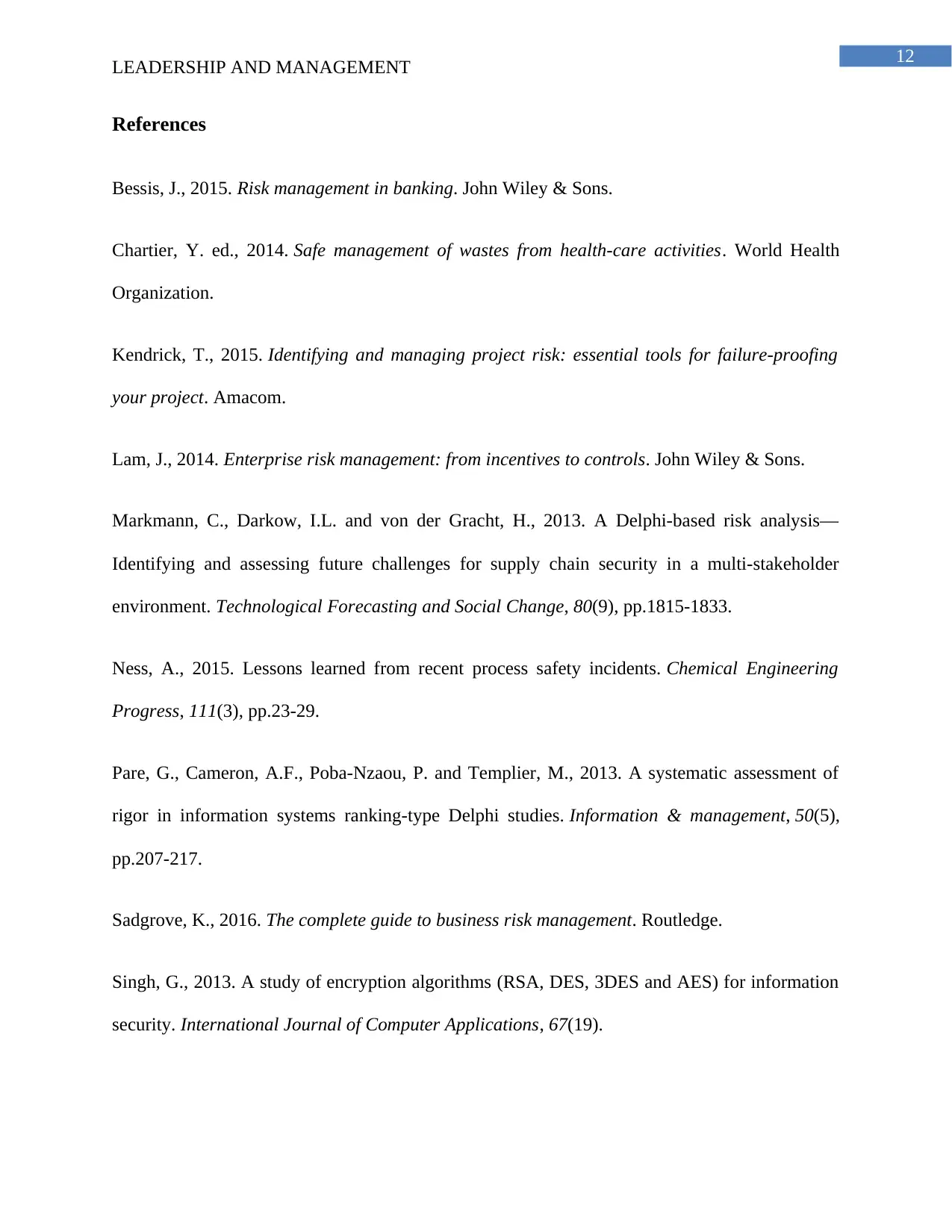
12
LEADERSHIP AND MANAGEMENT
References
Bessis, J., 2015. Risk management in banking. John Wiley & Sons.
Chartier, Y. ed., 2014. Safe management of wastes from health-care activities. World Health
Organization.
Kendrick, T., 2015. Identifying and managing project risk: essential tools for failure-proofing
your project. Amacom.
Lam, J., 2014. Enterprise risk management: from incentives to controls. John Wiley & Sons.
Markmann, C., Darkow, I.L. and von der Gracht, H., 2013. A Delphi-based risk analysis—
Identifying and assessing future challenges for supply chain security in a multi-stakeholder
environment. Technological Forecasting and Social Change, 80(9), pp.1815-1833.
Ness, A., 2015. Lessons learned from recent process safety incidents. Chemical Engineering
Progress, 111(3), pp.23-29.
Pare, G., Cameron, A.F., Poba-Nzaou, P. and Templier, M., 2013. A systematic assessment of
rigor in information systems ranking-type Delphi studies. Information & management, 50(5),
pp.207-217.
Sadgrove, K., 2016. The complete guide to business risk management. Routledge.
Singh, G., 2013. A study of encryption algorithms (RSA, DES, 3DES and AES) for information
security. International Journal of Computer Applications, 67(19).
LEADERSHIP AND MANAGEMENT
References
Bessis, J., 2015. Risk management in banking. John Wiley & Sons.
Chartier, Y. ed., 2014. Safe management of wastes from health-care activities. World Health
Organization.
Kendrick, T., 2015. Identifying and managing project risk: essential tools for failure-proofing
your project. Amacom.
Lam, J., 2014. Enterprise risk management: from incentives to controls. John Wiley & Sons.
Markmann, C., Darkow, I.L. and von der Gracht, H., 2013. A Delphi-based risk analysis—
Identifying and assessing future challenges for supply chain security in a multi-stakeholder
environment. Technological Forecasting and Social Change, 80(9), pp.1815-1833.
Ness, A., 2015. Lessons learned from recent process safety incidents. Chemical Engineering
Progress, 111(3), pp.23-29.
Pare, G., Cameron, A.F., Poba-Nzaou, P. and Templier, M., 2013. A systematic assessment of
rigor in information systems ranking-type Delphi studies. Information & management, 50(5),
pp.207-217.
Sadgrove, K., 2016. The complete guide to business risk management. Routledge.
Singh, G., 2013. A study of encryption algorithms (RSA, DES, 3DES and AES) for information
security. International Journal of Computer Applications, 67(19).
Paraphrase This Document
Need a fresh take? Get an instant paraphrase of this document with our AI Paraphraser
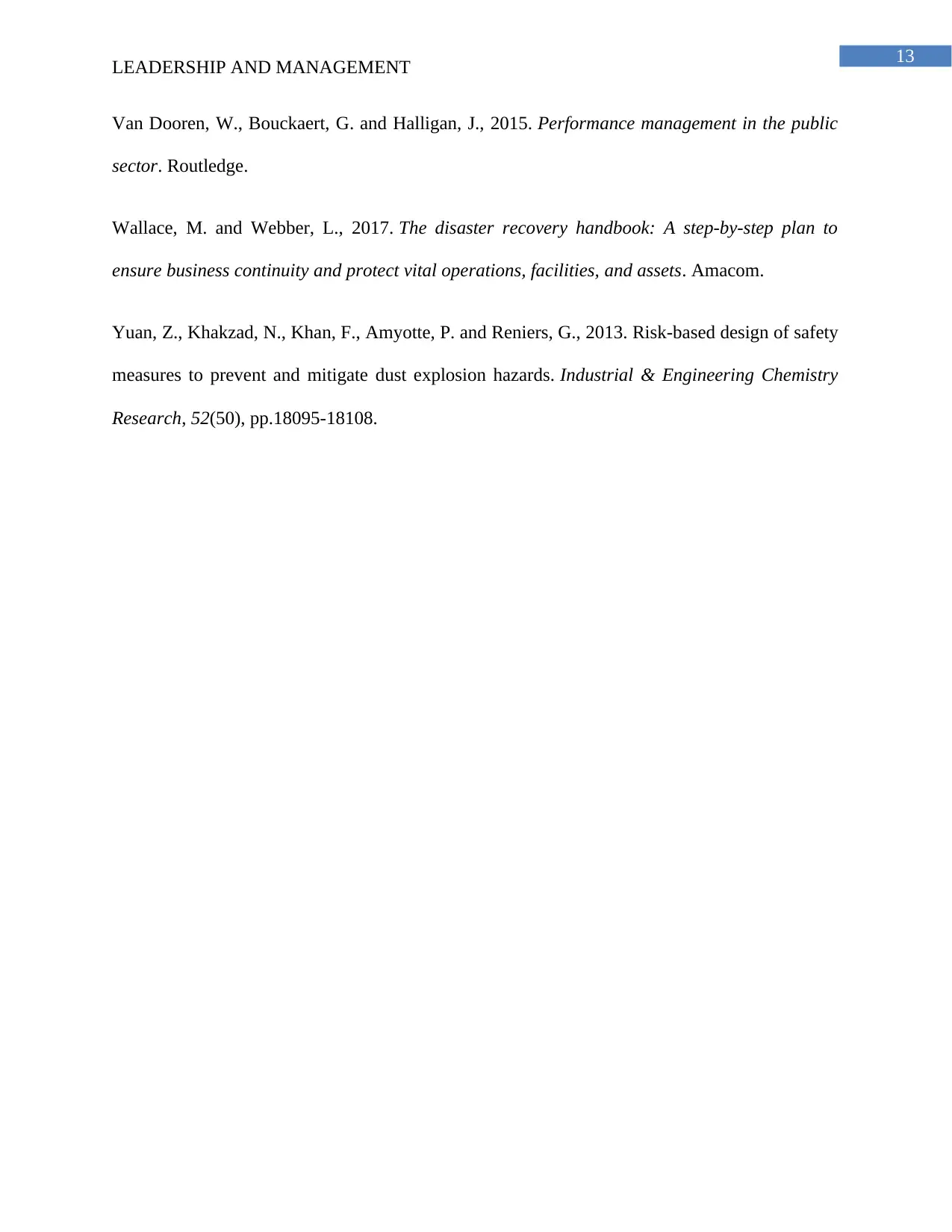
13
LEADERSHIP AND MANAGEMENT
Van Dooren, W., Bouckaert, G. and Halligan, J., 2015. Performance management in the public
sector. Routledge.
Wallace, M. and Webber, L., 2017. The disaster recovery handbook: A step-by-step plan to
ensure business continuity and protect vital operations, facilities, and assets. Amacom.
Yuan, Z., Khakzad, N., Khan, F., Amyotte, P. and Reniers, G., 2013. Risk-based design of safety
measures to prevent and mitigate dust explosion hazards. Industrial & Engineering Chemistry
Research, 52(50), pp.18095-18108.
LEADERSHIP AND MANAGEMENT
Van Dooren, W., Bouckaert, G. and Halligan, J., 2015. Performance management in the public
sector. Routledge.
Wallace, M. and Webber, L., 2017. The disaster recovery handbook: A step-by-step plan to
ensure business continuity and protect vital operations, facilities, and assets. Amacom.
Yuan, Z., Khakzad, N., Khan, F., Amyotte, P. and Reniers, G., 2013. Risk-based design of safety
measures to prevent and mitigate dust explosion hazards. Industrial & Engineering Chemistry
Research, 52(50), pp.18095-18108.
1 out of 14
Related Documents
Your All-in-One AI-Powered Toolkit for Academic Success.
+13062052269
info@desklib.com
Available 24*7 on WhatsApp / Email
![[object Object]](/_next/static/media/star-bottom.7253800d.svg)
Unlock your academic potential
© 2024 | Zucol Services PVT LTD | All rights reserved.





